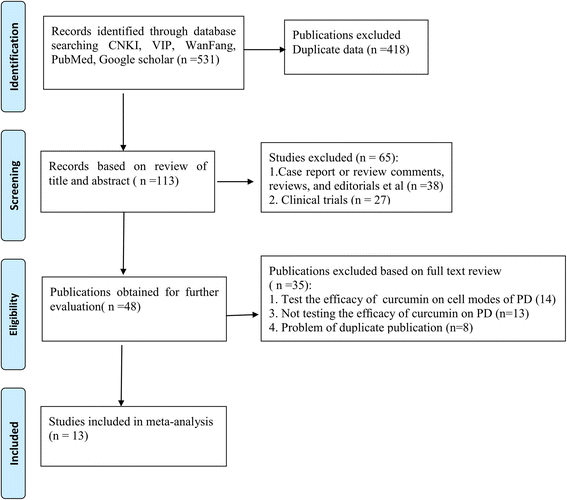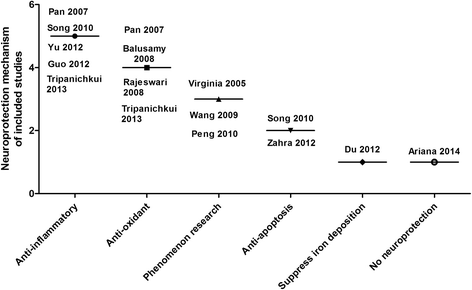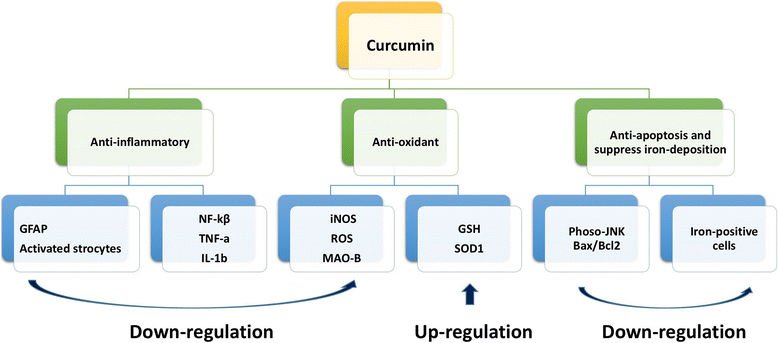Neuroprotective properties of curcumin in toxin-base animal models of Parkinson's disease: a systematic experiment literatures review
- PMID: 28818104
- PMCID: PMC5561616
- DOI: 10.1186/s12906-017-1922-x
Neuroprotective properties of curcumin in toxin-base animal models of Parkinson's disease: a systematic experiment literatures review
Abstract
Background: Curcumin (diferuloylmethane), a polyphenol extracted from the plant Curcuma longa, is widely used in Southeast Asia, China and India in food preparation and for medicinal purposes. Meanwhile, the neuroprotective actions of curcumin have been documented for experimental therapy in Parkinson's disease (PD).
Methods: In this study, we used a systematic review to comprehensively assess the efficacy of curcumin in experimental PD. Using electronic and manual search for the literatures, we identified studies describing the efficacy of curcumin in animal models of PD.
Results: We identified 13 studies with a total of 298 animals describing the efficacy of curcumin in animal models of PD. The methodological quality of all preclinical trials is ranged from 2 to 5. The majority of the experiment studies demonstrated that curcumin was more significantly neuroprotection effective than control groups for treating PD. Among them, five studies indicated that curcumin had an anti-inflammatory effect in the PD animal models (p < 0.05). Meanwhile, four studies showed the antioxidant capability of curcumin, by which it protected substantia nigra neurons and improved striatal dopamine levels. Furthermore, two studies in this review displayed that curcumin treatment was also effective in reducing neuronal apoptosis and improving functional outcome in animal models of PD. Most of the preclinical studies demonstrated the positive findings while one study reported that curcumin had no beneficial effects against Mn-induced disruption of hippocampal metal and neurotransmitter homeostasis.
Conclusions: The results demonstrated a marked efficacy of curcumin in experimental model of PD, suggesting curcumin probably a candidate neuroprotective drug for human PD patients.
Keywords: Animal models; Curcumin; Parkinson’s disease; Preclinical studies; Systematic review.
Conflict of interest statement
Authors’ Information
1 Department of Neurology, The First Affiliated Hospital of Wenzhou Medical University, Wenzhou 325,000, China.
2 The center of Traditional Chinese Medicine, The Second Affiliated Hospital & Yuying Children’s Hospital of Wenzhou Medical University, 325,027, Wenzhou, China.
3. The center of rehabilitation, The First Affiliated Hospital of Wenzhou Medical University, Wenzhou 35,000, China.
Ethics approval and consent to participate
Not applicable.
Consent for publication
Not applicable.
Competing interests
The authors declare that they have no conflict of interest.
Publisher’s Note
Springer Nature remains neutral with regard to jurisdictional claims in published maps and institutional affiliations.
Figures



Similar articles
-
Curcumin: a potential neuroprotective agent in Parkinson's disease.Curr Pharm Des. 2012;18(1):91-9. doi: 10.2174/138161212798918995. Curr Pharm Des. 2012. PMID: 22211691 Review.
-
Neuroprotective Activities of Curcumin in Parkinson's Disease: A Review of the Literature.Int J Mol Sci. 2021 Oct 18;22(20):11248. doi: 10.3390/ijms222011248. Int J Mol Sci. 2021. PMID: 34681908 Free PMC article. Review.
-
Neuroprotective effect of Demethoxycurcumin, a natural derivative of Curcumin on rotenone induced neurotoxicity in SH-SY 5Y Neuroblastoma cells.BMC Complement Altern Med. 2017 Apr 18;17(1):217. doi: 10.1186/s12906-017-1720-5. BMC Complement Altern Med. 2017. PMID: 28420370 Free PMC article.
-
Neuroprotective effect of curcumin nanoparticles against rat model of status epilepticus induced by pilocarpine.J Complement Integr Med. 2018 Mar 23;15(3). doi: 10.1515/jcim-2017-0117. J Complement Integr Med. 2018. PMID: 29570450 No abstract available.
-
Neuroprotective effects of baicalein in animal models of Parkinson's disease: A systematic review of experimental studies.Phytomedicine. 2019 Mar 1;55:302-309. doi: 10.1016/j.phymed.2018.09.215. Epub 2018 Sep 27. Phytomedicine. 2019. PMID: 30385133
Cited by
-
Curcumin Effectively Rescued Parkinson's Disease-Like Phenotypes in a Novel Drosophila melanogaster Model with dUCH Knockdown.Oxid Med Cell Longev. 2018 Jul 3;2018:2038267. doi: 10.1155/2018/2038267. eCollection 2018. Oxid Med Cell Longev. 2018. PMID: 30057672 Free PMC article.
-
Naringenin Produces Neuroprotection Against LPS-Induced Dopamine Neurotoxicity via the Inhibition of Microglial NLRP3 Inflammasome Activation.Front Immunol. 2019 May 1;10:936. doi: 10.3389/fimmu.2019.00936. eCollection 2019. Front Immunol. 2019. PMID: 31118933 Free PMC article.
-
Role of Dietary Supplements in the Management of Parkinson's Disease.Biomolecules. 2019 Jul 10;9(7):271. doi: 10.3390/biom9070271. Biomolecules. 2019. PMID: 31295842 Free PMC article. Review.
-
Administering Fixed Oral Doses of Curcumin to Rats through Voluntary Consumption.J Am Assoc Lab Anim Sci. 2018 Sep 1;57(5):508-512. doi: 10.30802/AALAS-JAALAS-17-000143. Epub 2018 Aug 29. J Am Assoc Lab Anim Sci. 2018. PMID: 30157991 Free PMC article.
-
Use of Curcumin, a Natural Polyphenol for Targeting Molecular Pathways in Treating Age-Related Neurodegenerative Diseases.Int J Mol Sci. 2018 May 31;19(6):1637. doi: 10.3390/ijms19061637. Int J Mol Sci. 2018. PMID: 29857538 Free PMC article. Review.
References
-
- Connolly BS, Lang AE. Pharmacological treatment of Parkinson disease: a review. JAMA. 2014 Apr 23–30;311(16):1670–83. - PubMed
-
- Driver JA, Logroscino G, Gaziano JM, Kurth T. Incidence and remaining lifetime risk of Parkinson disease in advanced age. Neurology. 2009;72(5):432–438. doi: 10.1212/01.wnl.0000341769.50075.bb. - DOI - PMC - PubMed
-
- Dorsey ER, Constantinescu R, Thompson JP, Biglan KM, Holloway RG, Kieburtz K, Marshall FJ, Ravina BM, Schifitto G, Siderowf A, Tanner CM. Projected number of people with Parkinson disease in the most populous nations, 2005 through 2030.Neurology. 2007 Jan 30;68(5):384–5. 5.Fahn S. The history of dopamine and levodopa in the treatment of Parkinson's disease. Mov Disord. 2008;23 Suppl 3:S497–508. - PubMed
-
- Morgante L, Morgante F, Moro E, Epifanio A, Girlanda P, Ragonese P, Antonini A, Barone P, Bonuccelli U, Contarino MF, Capus L, Ceravolo MG, Marconi R, Ceravolo R, D'Amelio M , Savettieri G. How many parkinsonian patients are suitable candidates for deep brain stimulation of subthalamic nucleus? Results of a questionnaire. Parkinsonism Relat Disord 2007 Dec;13(8):528–531. - PubMed
Publication types
MeSH terms
Substances
LinkOut - more resources
Full Text Sources
Other Literature Sources
Medical

